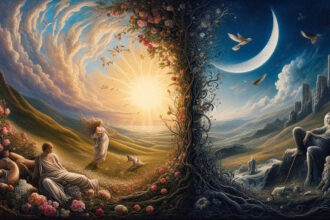- Metaphysical Conceits: Complex metaphors to compare the lovers to flies, tapers, and eagles and doves
- Follows consistent rhyme scheme of 'abbacccaa', Donne's Metaphysical poetry style.
- Love as microcosm and Love's harmlessness.
- Phoenix Metaphor: Lovers are likened to a Phoenix.
- Aspiration to Sainthood.
- Immortality through Poetry.
The Canonization is a renowned poem by John Donne, written in the 1590 and first published in 1633, poem is a profound exploration of love and its power to transcend the mundane and achieve a form of sainthood. The Canonization is a fine example of Donne’s way of blurring the lines between the sacred and the profane, as the poem elevates a secular love to the status of divine.
Brief Introduction of the Poem
The Canonization1 is one of the finest poems of John Donne. This poem is selected in the ‘Songs and Sonnets’ and it stands alone among all the pieces of ‘Songs and Sonnets’. The Character who is speaking rejects the worldly wise advice offered to him and vindicates his own abandonment to passion.
John Donne’s poem “The Canonization” consists of five stanzas, each containing nine lines. The poem follows a consistent rhyme scheme of abbacccaa. This is a signature of Donne’s metaphysical poetry style.
1st and 2nd Stanza of the poem
The famous opening line- “For God sake hold your tongue, and let me love”, shows us Donne at his best in his own familiar style. In the lines of first stanza he makes fun of himself-
Or Chide my palsie, or my gout
My five gray haires, or ruin’d fortune flout.
and in the next lines of his friend-
Observe his honour, or his grace,
Or the kings real, or his stamped face
Contemplate, what you will, apporve,
and in the last of the stanza he shows all the strength of his passion in the appeal- that do anything “So you will let me love”.
This like satirical description reappears in the second stanza and in this stanza it sounds more clearly. The next lines are most satirical amplifications-
What merchants ships have my sighs drown’d?
who saies my tears have overflow’d his ground?
When did my colds a forward spring remove?
When did the heats which my veins fill
Adde one more to the plague Bill?
and next three lines satire continues the description and becomes move stinging.
Soldiers finde warres, and Lawyers finde out still
Litigious men, which quarrels move,
Though she and I do live.
In these first two stanzas the speaker has lectured his unsympathetic listener on the complete independence of his love from the scrambling and quarrelsome world of Kings, of courtiers, scholars, merchants, soldiers and lawyers.
3rd Stanza of the poem
In the third stanza he takes change in his tone by inviting the listener, whom he first told to be silent, now to ‘call’ the lovers whatever he pleases, not only in the sense of ‘identify of define the lovers’ but also ‘insult the lovers’. In this stanza he has told others to mind their own business and proved the harmlessness of his own all engrossing pursuit-
Call her one, mee another flye,
We’re Tapers too, and at our owne cost die,
It means nobody suffers a loss by lovers’ death. The main idea, in the stanza, of justification by love enters now-“Call us what you will, we are made such by love.” and not only justification-ennoblement – “And we in us finde the Eagle and the Dove.”
This metaphor of the birds was suggested by that of the insects, and corrects it; in the erotic-mystical language of the time ‘eagle’ stands for ‘strength’ and ‘dove’ for ‘tenderness and purity’. Remember Crashaw’s appeal to St. Theresa-“By all the eagle in thee, all the dove”. Another comparison with the ‘phoenix’ is a ‘ridle’, which the speaker seems to explicate almost casually, with a literary cliche- “We two, being one, are it”.
With the ‘Phoenix’ Donne openly reverts to the type of traditional hyperbole he has just ridiculed,but he wears the hackneyed symbol with a difference-
The phoenix ridle hath more wit
By is we two being one, are it.
The fabulous bird, being unique of its kind, united in himself both sexes; the two lovers, having combined into one neutral thing, have also acquired this other property of the phoenix; they “dye and rise the same’ as before.
4th Stanza of the poem
In stanza four the speaker then promises a future publication of love’s mysteries in ‘sonnets’ or ‘hymns’ by which all who have formerly criticized or misinterpreted the lovers will learn to-
approve
Us canonized for love.
This stanza admits the hard fact, but answers defiantly-“We can dye by it, If not live by love.” In the stanza poet points that this love of the pair is a mystery; therefore they will have a ‘legend’, and this fame of love will lost safely, if not in ‘a chronicle’, at least in ‘sonnets’ and ‘hymns’. This word has a religious importance and it leads up the announcement that the poet and his mistress will be “Canonized for love”, and here the stanza fourth ends.
In the same manner Shakespeare also immortalizes his love in the pretty sonnets or in verse, but something is different here. When Shakespeare says2–
Nor shall Death brag thou wanderest in his shade
When in eternal lines to time thou growest’
So long as men can breathe or eyes can see
So long lives this,and this gives life to thee.
and again-
Even if you do thy worst, O Time,
My love, shall in my verse ever live long.
He clears the immortality of verse of course, but in fact he is centered on himself only. He boasts and proves his supreme mastery of a theme or a verse of his own. Donne in these lines immortalizes his love in all forthcoming sonnets-not of his own, but of others.
The Last Stanza
Finally he imagines the form in which the world edified by such ‘hymns’ would express its approval. In this stanza Donne expresses the power of love and the power of Sonnets and hymns also. When the speaker has proved his quality to express and explain his mysterious experience in sonnets and hymns- the previously rejected world by him as vicious and vulgar, has proved capable of conversation to his vision, his values and Donne celebrates this understanding in the last stanza.
It proves that Love is long-live and if it had not proved during it lives, it will be proved after being the mystery and whole world shall accept it and will continue to study such like sonnets; and these hymns will become the torch-bearers of future lovers.
Note
Below are the links you can enjoy-
- Hindi translation of the poem ‘The Canonization’. [External Link]
- A short note on ‘Sonnet No. 18: Shakespeare’. [Click to Read]











